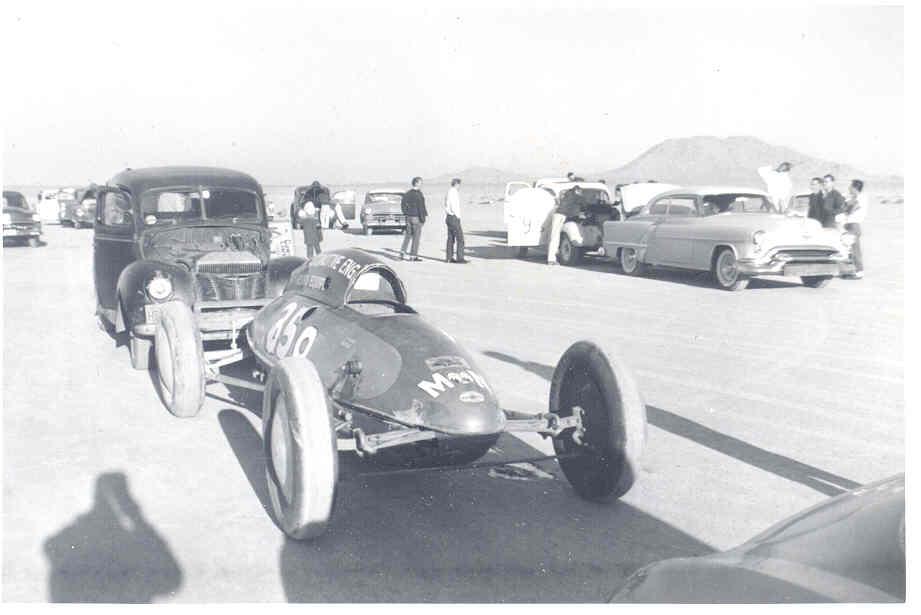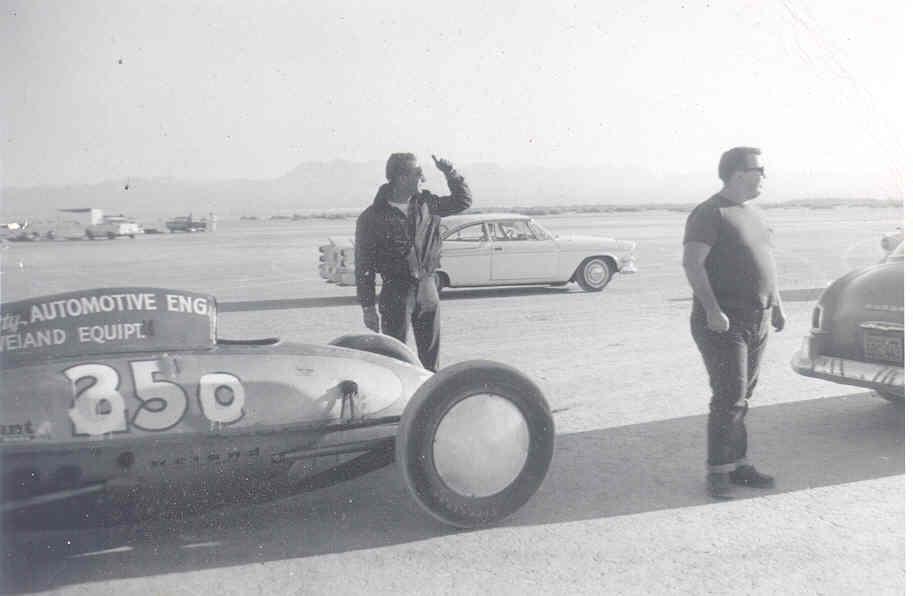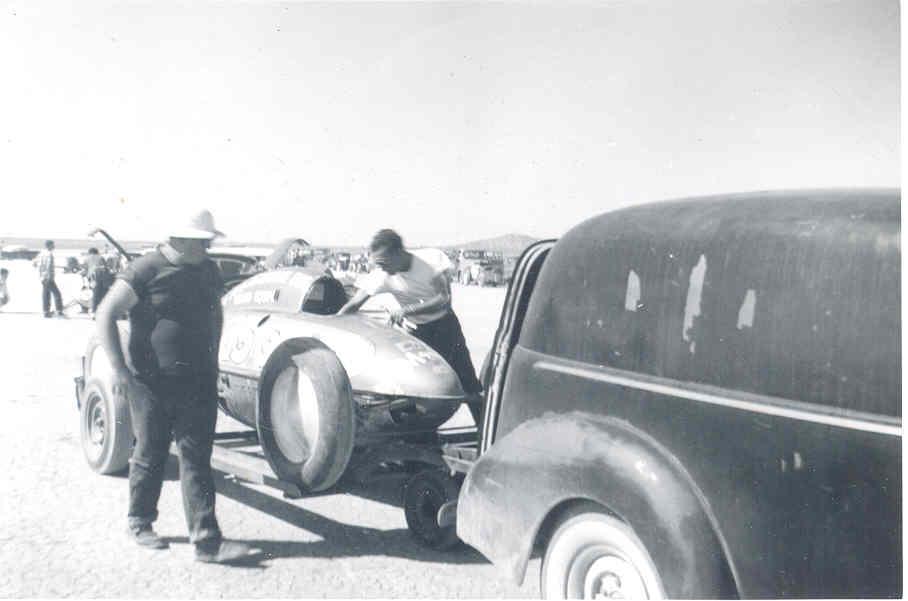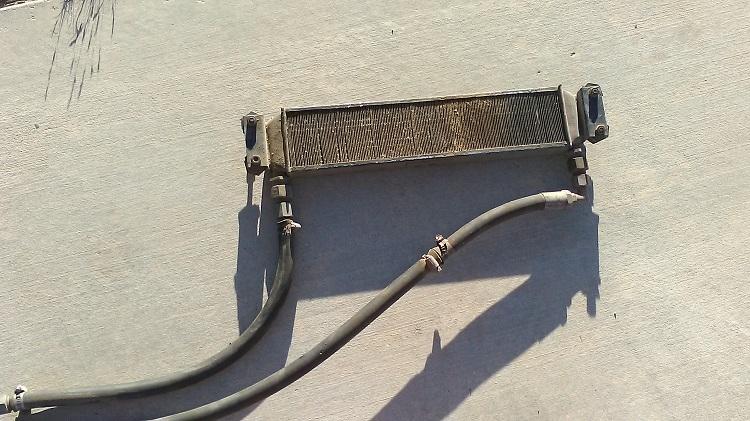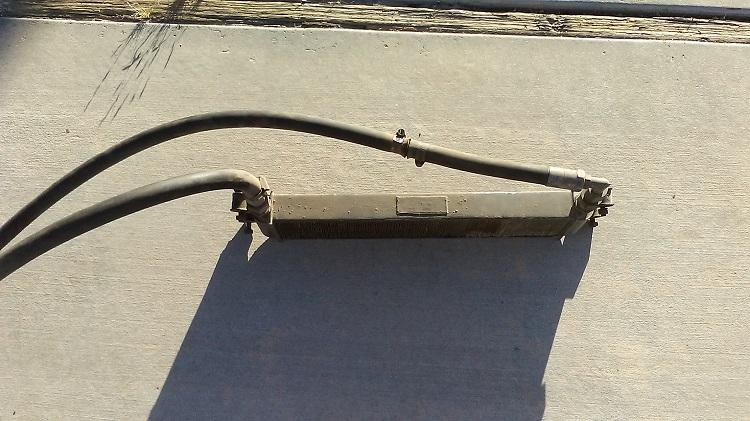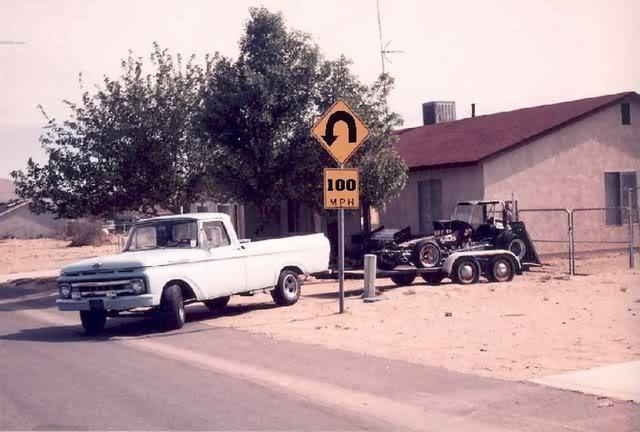-
Posts
365 -
Joined
-
Last visited
Content Type
Profiles
Forums
Events
Gallery
Everything posted by DustyMojave
-
That '67 Terlingua Mustang from the NNL is really nice (even if he DID miss the sides of the rear window). For those building models of that car, I can offer some advice other than the paint on the underside of the belly of the car. - He got it right painting the top of the front shocks where they show in the ends of the export braces. Shelby's guys installed Koni shocks on those cars. Most all of teh Trans Am race cars of teh era used them. The orange is nice, but the proper color for Konis is closer to Chevy engine red. - All of those Trans Am Mustangs that Shelby built (25 to 27 depending on info source) were all painted at the Ford San Jose factory the same Wimbledon white that all of the Shelby cars were delivered in. The Shelby Team race cars (4 of them) were over-painted with, as Shelby called it, "that godawful yellow" in the Shelby shop. They were race cars, not show cars like many race cars get "restored". So color matching all through the car was not considered important. Any interior areas like the floor, inside of the trunk, underside of the hood, top of the firewall above the export braces, door jams, etc. should be painted Wimbledon white. Some of those areas having some yellow overspray on the edges would be appropriate. - The top of the rear package shelf inside the rear window should be flat black.
-
Without wanting to extend an argument, I'd like to point out that the underside of a car needs to be protected by some means. That might be galvanizing, might be gloss paint, might be primer, though primer is nearly always porous and will collect water rather than shed it off. thus the belly would rust terribly badly if primer is all that is there. Whatever that means is, it will cost the car maker money. Aint nothin' free in this world. In the 1960s, American car makers offered rubberized tar spray undercoating on their cars. But that was a dealer applied option. Many cars did not get that additional cost option added on. So what protected them? Cars with body on frame construction, the frame was painted "chassis black". The underside of the body still needed protection. What do you "paint overspray" guys think was used for that? As I said above...Some cars got primer on the belly and some overspray. Some got dipped, some got sprayed with the same gloss finish as the upper surfaces. Some got a spray of chassis black. But then, lots of cars rusted away pretty quickly then.
-

Cooper barn find
DustyMojave replied to absmiami's topic in WIP: Other Racing: Road Racing, Land Speed Racers
Nice work! But I have to take issue with the statement that "this Cooper was one of the first race cars with indep rear suspension". Porsches of the same era had independent rear suspension. Swing axle with joints that are definitely not u-joints. And the same Dr. Porsche headed the GP team at Auto Union in the 1930s with independent rear suspension race cars. Again, not u-joints. But it is independent rear suspension. Others tried it too. But the Cooper 500 was a neat and innovative little race car that I'm quite fond of. -
Since Revell and Monogram got the front ends so wrong on their '69 and '70 Mustangs, and AMT and MPC did so much better (but still got the grilles wrong); but AMT and MPC got the chassis and engine compartment so wrong, it's good that you used the Revell chassis and the AMT body shell. It makes the model come out much better that way.
-
Yes Chrysler DID sell 2-door 1st Gen Valiants. I had a friend in high school (early 70s) who had a 62 Valiant 2-door. He built it as an early version of what later came to be called Pro Street. Put in a Hemi with a tunnel ram. Lowered the front ride height. Dana 60 rear axle. roll bar with rear braces. No back seat, just a sheet of aluminum to close off where the seat back had been. Wide cheater slicks in the back and skinny little 5.60-15 tires up front. Slot mags all around. He found a trunk lid without the continental tire shape. Painted the car bright yellow. He had a part-time job at a car parts in the morning, then he used to come back to the school at lunch time and bring the car in to the auto shop class in the middle of the campus. He would stop next to the lunch pavilion. Then light up the tires and smoke em for a while before moving on to the shop. Interesting show in the middle of a high school where the vast majority were low riders.
-
Yup. Been there, seen that photo before, Mike. Note that the body in the midground is on a hanging fixture . The bodies on left are heading upstairs. The body in the foreground still has more structure to be added before it gets painted. Note the quarter panel/roof seam has not been filled, and there is more to be added back by the trunk. Different manufacturers may well have used somewhat different methods. And I'm not working from "memory" on this issue. Nor judging based on restored cars, or re-pained cars. I'm basing my statements about Fords (and I see the Falcon in your avatar) on the original paint on the 2 Falcons in my back yard and the Mustang of the type this model build is about that I showed you pics of. Both of my Falcons were built in the same San Jose plant that Shelby's Mustangs were all built in. One of those Falcons was purchased new by my grandparents and still has original paint inside and underneath. The other is still in its original Wimbledon white. That Shelby Mustang I took entirely apart and removed rust damaged parts of the body structure. Yeah, my friend's 68 Roadrunner Hemi had blue metallic overspray on the primer under the rubberized undercoat dealer sprayed underneath. This isn't a Roadrunner or a Mopar at all. It isn't a GM product either. We can keep arguing. I have reported what I found. Not what somebody told me. Not based on memory. Or what's in a recent magazine or old black and white pictures that may be from a different plant.
-

K&R Kustoms+Rods belly tanker update: 8/12/17
DustyMojave replied to Rocking Rodney Rat's topic in WIP: Model Cars
Tom is the slender guy, the other guy shown is "Fat Eddie". Nice guy, Eddie used to always put a nickle in the shop soda machine for me to pick out a soda from. Old "chest" style vending machine you put in a nickle (yup...5 cents) and pulled the cap end of the 10oz. bottle you wanted. Toms car was the 1st car to break 180mph at El Mirage, and the 1st to break 200mph. Running used wrecking yard flathead engines. That 40 Ford Sedan Delivery to tow it and push start it was no slouch either. He had 2. Both eventually got blown olds Rocket engines. Tom and Eddie were at Bonneville working on the belly tank, when Art Arfons came up and asked them to push start his Allison aircraft engined "Green Monster" Land Speed Record car (the car before they went to jet engines). Art and his brother had been trying with their pickup and couldn't get the Monster going fast enough to fire. So Tom and Eddie jumped into the 40 Ford, loaded with 2 spare engines, a roll-away tool box, all sorts of spare bits and pieces and tires and what not, and proceeded to push the Monster down the black line of the course. The Monster never did get going, But Tom pushed it through the lights still trying. That set an unofficial speed record for a production Utility vehicle that may still stand. I know that in the 1990s, GM engineers tried to beat that speed with their Syclone supercharged S15 GMC. All of GM's money and technology and they came up about 10mph short of Tom's speed heavily loaded and pushing a huge land speed record car with a huge aircraft engine IN GEAR! Then for about 25 years or more, Tom rented a shop from my best friends and after he passed away, that shop was where I worked out of. Congrats on getting the king pin angle right on your front axle. Most model builders would just make the king pin straight up and down. But then the steering isn't right. It should be about 10° as you did there. -

K&R Kustoms+Rods belly tanker update: 8/12/17
DustyMojave replied to Rocking Rodney Rat's topic in WIP: Model Cars
Sweet subject. The 1st race car I ever sat in was Tom Beatty's belly tank back in the 1950s. Here's a pic of that car taken by my dad at El Mirage. For the last 29 years I've lived where I can see the hills around El Mirage from my home. -
Oh, the power steering ram should be removed. No power steering used in road race cars in those days. Not against the rules, just not used. Eats more horsepower and things that are not there cannot fail. You're welcome for any help I can provide. Let me know if there's any part I might have pics of that you need to see. I know this is your model and I don't mean to tell you how you HAVE TO build it. But since I was there then and have restored a few 1:1 Trans Am race cars, I have some knowledge to share.
-
-
Interior. Ignore the blankets used to protect the paint while we were building the car. And where Shelby mounted the oil cooler. I have one of the original Harrison/Shelby oil coolers in my garage. I posted a couple of pics of it in AFX's thread on his '64 Falcon on Road Race Model cars Forum.
-
By the way... I've been criticized pretty harshly by those who think they know for those welds looking so crappy. I worked hard to make them look like the original welds. The originals looked like that and lasted nearly 50 years. I even had to grind out and re-do some welds because they came out too nice. A nice stack of dimes is NOT how race cars were built in the 1960s. So...More pics, starting with the covers for the traction bars:
-
Roll bar. Horizontal bar that goes all the way across is not original Shelby. It was added to put the shoulder harnesses at the right height for Fred, who is tall. Then the over-rider traction bars are shown. Axle end and then interior brackets. I had to re-make these interior brackets as the originals were damaged by someone putting in bolts that were too small and it egged out the holes. There is a slot cut in the floor panel just inboard of the wheel well for the traction bar.
-
Good work Phil. Some time back I posted a thread in the 1:1 car photos section of pictures I took of one of the Shelby '67 TA Mustangs that I worked on restoring. Phototoilet killed those pictures. But I can post some in here as attachments. It only lets me do that 3 pictures at a time. But I'll do what I can. I was a Tech Inspector for SCCA races when this car was new. The Shelby Mustangs actually were NOT the 1st Trans Am racers to be acid dipped. Actually Shelby didn't dip any of them as they built them. I worked with John Timanus (SCCA Pro Series Tech Chief) and my dad (Jack Parcells - Cal Club [SCCA So Cal Region] Chief of Rules Enforcement) to inspect AND REJECT Smokey Yunick's 67 Camaro at Riverside. THAT car was ACID DIPPED!!!! I Tech inspected the one I later restored which was Fred Sutherland's. The rear leaf springs used on the race cars were narrower than stock, and were spaced toward the inboard side of the perches and shackles to allow tire room. It seems like the engine winds up rather far forward in the engine bay in that AMT '67 chassis. I'll have to look into that in my '67 build. The Shelby '67 Mustangs were all shipped from the San Jose Ford plant in Wimbledon white. In dismantling the Sutherland Mustang, I found Wimbledon white inside the car, under the dashboard, under the belly, inside the front and rear wheel wells, and under the semi-gloss black in the engine bay. It appears to me that Ford painted the entire car the same color. The engine bay and front of the core support were then painted black. My '61 Falcon is ALL Algiers Bronze, my '64 Falcon is ALL Wimbledon White. Bruce Springsteen's '69 Galaxie Convertible I did some restoration work on is ALL Gulfstream Aqua. There was none of the "primer over sprayed with finish color under the belly" type of paint application that is SO popular with "restorers". Seems more accurate for Mopars. I would say for the paint of your model to be totally right it should be Wimbledon white under the belly with maybe some "God-Awful Yellow" overspray near the edges. That would have made for less work cutting things apart for paint. That yellow, BTW, is a Corvette color. Shelby sent one of the shop employees down to the local paint supply shop they dealt with to pick up some paint for the Shelby Team race cars. They had some yellow that had not been picked up, so they sold it to him cheap. Shelby wasn't real happy, others liked it. But it wound up making for a pretty good looking and distinctive paint scheme. Jerry Titus was an interesting character. Fun personality and quite a good race car driver. Probably would have made a good car salesman if he had turned his attention that way. His son Rick worked with me on a race team (Ron Dykes Sunbeam Tiger) in 1968. For 1967, your model is correct to have a stock gas tank, as that was required in '67. In '68 fuel cells were allowed by the rules. 289 engine built by Shelby guy Dave Dralle whose shop is at Willow Springs Raceway - 487hp. But after initial track test, it got switched to single Holley for slightly less hp, but better tractability. This car held the A/Sedan track record at Willow in 1967-69. Note how the 289 sits in the engine bay compared to the AMT fit.
-
Another side story to the Scarab, is that the owner, Lance Reventlow, kept that Scarab 2 race car after it was retired from racing, and had his shop convert it to a street registered car and used it on the street for many years. It was painted a deep metallic blue and had gold scallops on it. It looked really pretty that way too. There MAY be some pics of it that way on the internet somewhere. Hmmm... I'm thinking it might have been Lance's friend Augie Pabst (of the brewing family) that wound up with the Scarab. The car was built for Lance like all the Scarabs. Augie raced Scarabs for Lance...Hmmmm....Anyway... I was looking for something else in my model kit warehouse this morning and ran across that Scarab kit. I oughta haul it out soon and start on it.
-
Beautiful build. I was born in Van Nuys, CA. Then moved to San Fernando in '56. Galpin Ford was born in San Fernando. Then in 66 moved to Van Nuys. Kinda crossed paths. For years I bought most all of my parts for my Fords from Galpin's parts department. World's largest Ford dealer for decades and still are. Also Number 1 Jag, Saturn, Mazda, and most everything else they decide to sell. As for the designation of A/GS...can't blame the model builder for putting the markings on the model just as they are on the full scale car he's building a model of. But as guy who grew up around car racing and has spent many years making a living restoring vintage race cars and hot rods and building cars that weren't racers before into "vintage racers", I've come to the conclusion that in the world of vintage racing, there is a huge amount of what I call "creative memory". Lots of people involved who weren't there when that sort of racer was actually "racing", but have the money to pay for getting involved in it now. So such inaccuracies happen ALL THE TIME. Lots of vintage racers are built these days not for actual racing, but for magazines, internet articles, car shows, etc. If it actually got raced, it would have to have the correct markings. But as a show car, they get away with such inaccuracies. Ron was right "A/GS" DOES stand for "A/Gas Supercharged" The appropriate designation would have been A/G, or more probably D/G, as that big sedan is an awfully heavy car compared to a little bitty Anglia or some of the other cars that ran in A/G in the day. Most '55 Chevies, 57 Fords and such raced in the day in B, C or D/G with big block engines. The classes were broken down according to weight in pounds per cubic inch of engine.
-
Very nicely done. I saw the full scale one in person at races like Santa Barbara and Riverside in the early 60s. You've done an excellent job capturing the original of the era rather than the "restored" race car like so many models are built these days. Right color belts, Webers through the intake openings in the engine cover, etc. Are those Webers mounted to a pair of boxes attached under the body? Or is there an engine, etc. under the body?
-

Cooper barn find
DustyMojave replied to absmiami's topic in WIP: Other Racing: Road Racing, Land Speed Racers
LOL! I bought my 1st model kit in 1960 from a gentleman who owned and raced a Cooper 500 here in SoCal. Harry Morrow owned a bookstore that is still in business in Burbank, CA. - Autobooks. Jay Leno is an often customer. As a kid I used to watch Harry and a few others race their Cooper 500s. Another model builder I know, Dale King, grew up near Harry's store and as a young man built a very detailed larger scale model of Harry's Cooper, going to Harry's house to take measurements and pictures. Awesome model. I still have a few pieces of my older brother's Merit Cooper in my parts boxes. That model was crushed in an earthquake in 1971. I have a resin kit by So Cal modeler Herb Deeks, who did the resin kit w/ white metal engine and suspension taking molds from the Merit parts. Read more: http://race-car-models.proboards.com/thread/225/59-cooper-500-mk-ix#ixzz4pIlcirdX -
It's about a 1923. But it's REALLY CRUDE and toy-like. The cowl in particular should have a concave curve from the firewall to the windshield. But you can have plenty of fun with it. Putting in the 6-in-a-row is a cool idea. Ford flat head V8 fans back in the day used to say "6-in-a-row don't go." But the GM 6 was larger displacement than the flat head V8. And it was pushrod so the intake and exhaust ports flowed a whole lot better that the flat head. I suggest starting by cutting off the strange panels alongside the engine. Maybe raise the front spring perch on the frame to lower the front. Add a rear kickup to the back of the frame with a transverse spring and make the pickup bed more shallow, but with the top at the same height. But those are my thoughts about it. Your model. Have fun with it.
-

1968 Shelby Green Hornet-----Update! 8/4/18
DustyMojave replied to MrObsessive's topic in WIP: Model Cars
Good info. My F100 in the attachment. Crappy old pic with some minor early photoshop adjustment of the road sign The actual sign was a 90° bend and 10mph...More fun this way thanks to a friend on another model site. -
At least they weren't acid dipped as long as Smokey Yunick's '67 Camaro. (The 1st one, not the one that Christy Edelbrock has been vintage racing for several years) That car was so thin the breeze in the paddock at Riverside was rippling the roof panel while we were Tech Inspecting it. One could not lean against any panel to examine it without denting the car. There were so many things blatantly violating the rules in that car that Tech Chief John Timanus told Smokey to never ever bring that thing around again. Full belly pan, reshaped body panels, plastic rear window, etc. ... About as true to Chevy showroom product as a Picasso is to a photograph.
-

1965 Mercury Comet Cyclone (update 1/4/19) Finished!
DustyMojave replied to RancheroSteve's topic in WIP: Model Cars
Interesting touch adding the snubber mount. And the black spray winds up looking very much like rubberized undercoating. -
Revell 40 I presume?
-
The "Lightweight" Falcons were special model created by Ford originally to allow them to race that way in FIA competition such as FIA World Rally (Modern WRC) and in FIA Group 2 in international Competition. Any cars raced in production-based race classes were required to be "Homologated" by the factory with paperwork indicating how the car is built and specifications for it, and with proof of production of a certain quantity of cars built that way. Since SCCA was the FIA sanctioned race organization in the US, Sedan and Production Sports Car class race cars were required by SCCA to be homologated. Ford homologated Falcons specifically for the Monte Carlo FIA rally in '63, being the 1st of the season and most well-known event of the World Rally series. Like the Indy 500 of Rallying. They were used the rest of the season too but were known by the Monte Carlo name. Special equipment was used to make the cars competitive against lightweight sports cars by European manufacturers. Fiberglass hood, doors, trunk lid and front fenders. Plexiglass door, windwing, back and rear 1/4 windows with fabricated aluminum (instead of much heavier diecast zinc) frames for all the side windows, K-code hi performance engines, HD clutch and T10 trans with optional gear ratios, tubular headers, special large diameter (2.5") exhaust with Ferrari hangers (little rubber straps with metal ends), wider wheel rims, spindles, 9" rear axle and brakes as used in the Galaxie, heavy duty springs and sway bar, and a number of other special features were included. The engine compartment brace that came to be called a "Monte Carlo bar" and new mounting holes for the front upper a-arms 1" below the standard ones and most of the rest of the features of the later Shelby GT350 R were developed for the Falcons before Mustangs were in production. 64s were also homologated with this set of features. For 1965, Ford homologated GT350s. Ford offered for sale all the special parts for the Monte Carlo Falcons (and the later GT350Rs) through all Ford dealer's parts departments. I worked on restoring one of the original 1:1 Monte Carlo Falcons back in the 1990s and learned of some of the features I hadn't known about earlier. Many of the Monte Carlo Falcon features were used on the blue number 17 A/Sedan Falcon of Pete Cordts shown above in restored condition in the picture from the Monterey Historics. His car started life as a 1963 and was raced that way for a year painted Chestnut metallic. For the '64 season he re-bodied the car as a '64. He worked at Shelby's shop at the time. Later, he replaced the Falcon with a '67 Shelby Trans Am Mustang. Then later still, after I had Tech Inspected his race cars many times, he worked Tech Inspection alongside of me. Great guy. Just to be clear...Ford was FAR from cheating in homologating with these features or even unusual in doing so. Manufacturers from Austin Healey to Ferrari to Chevy and Pontiac did such things in homologating special edition models of their cars for competition.
-
The kit being used here is an all new tool in 1/25 scale by Revell 1st released a year or 2 ago. This is NOT the old 1980s inaccurate Monogram 1/24 scale tool re-issued again. Although the green hood is from that old Monogram kit trimmed down slightly to fit in the 1/25 scale body. Apparently you think the new Revell 1/25 kit is just the old Monogram recycled again. If that's the case, then I suggest you check out the new Revell 'Cuda kit. It's still not perfect, it IS a model car kit, but it's WAY better than the old Cuda and Challenger kits. Your wish HAS come true.

